SUPPORT: AFOSR MURI, NSF CMMI DEMS Program
PROJECT DESCRIPTION: In this project, we combine a generalized finite element method (referred to as Interface-enriched Generalized Finite Element Method or IGFEM) developed in-house with a shape optimization scheme (based either on genetic algorithm or a gradient-based approach) to perform the computational design of biomimetic microvascular materials with active cooling capabilities. At the heart of the problem is the ability to model in an accurate and efficient fashion the cooling effect created by complex network of microchannels embedded in a polymeric component subjected to a variety of thermal loading. Objective functions include the flow efficiency and void volume fraction associated with the microvascular network, and the maximum temperature obtained in the thermally loaded domain. Current emphasis is placed in incorporating ths technology in a 3d fiber-reinforced composite to be used for high temperature applications. the challenge here consists in combining the presence of the microvascular network with the complex microstructure of the composite and to investigate the impact of the embedded network on the thermal and structural response of the composite.
Applications for this technology include microvascular composites for the hybrid skin of hypersonic vehicles, microvascular composite panels for the active cooling of electric car batteries, and microvascular composite panels for active radiative cooling of nano satellites.
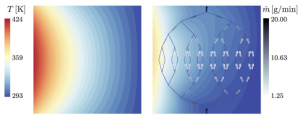
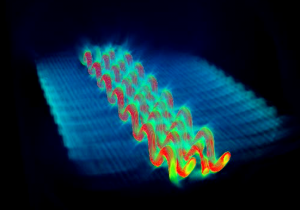
Micro-CT image of a glass-epoxy composite containing four wavy parallel micro channels made using the sacrificial fiber approach developed at the University of Illinois.
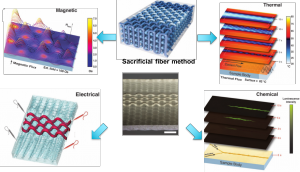
Potential applications of microvascular composites made using the sacrificial fiber method: Based on the fluid flowing through the embedded network, one can modify the magnetic, electrical, chemical or thermal properties of the material.
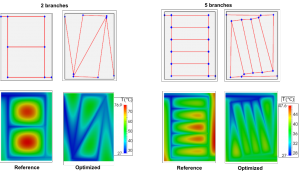
Reference and optimized designs (and associated IGFEM-predicted temperature field) for a microvascular composite panel used for the active cooling of electric car batteries.
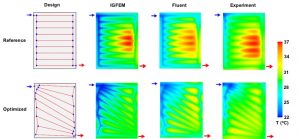
Design and surface temperature profiles for a microvascular composite subjected to a 500 W/m^2 heat flux, with a 28 mL/min flow rate of 50/50 water/ethylene glycol. The second, third and fourth columns respectively correspond to the IGFEM prediction, FLUENT simulation and experimental validation results.
RELATED PUBLICATIONS:
- Aragón, A. M., Wayer, J. K., Geubelle, P. H., Goldberg, D. E. and White, S. R. (2008) “Design of microvascular flow networks using multi-objective genetic algorithms”. Comp. Methods Applied Mech. Eng., 197, 4399-4410. DOI: 10.1016/j.cma.2008.05.025.
- Aragón, A. M., Hansen, C. J., Wu, W., Geubelle, P. H., Lewis, J. and White, S. R. “Computational design and optimization of a biomimetic self healing/cooling material.” In Behavior and Mechanics of Multifunctional and Composite Materials 2007, Edited by M. J. Dapino. Proceedings of SPIE, 6526. San Diego, CA, March 2007.
- Olugebefola, S. C., Aragón, A. M., Hansen, C. J., Hamilton, A. R., Kozola, B. D., Geubelle, P. H., Lewis, J. A., Sottos, N. R., and White, S. R. (2010) “Polymer-microvascular network composites.” Journal of Composite Materials, 44:22, 2587-2603. DOI: 10.1177/0021998310371537.
- Wu, W., Hansen, C.L., Aragón, A.M., Geubelle, P.H., White, S.R. and Lewis, J.A. (2009) “Direct-write assembly of biomimetic microvascular networks for efficient fluid transport.” Soft Matter Communication, 6:4, 739-742.
- Aragón, A. M., Smith, K. J., Geubelle, P. H. and White, S. R. (2011) “Multi-physics design of microvascular materials for active cooling applications.” Journal of Computational Physics, 230, 5178-5198. doi:10.1016/j.jcp.2011.03.012.
- Soghrati, S., Thakre, P. R., White, S. R., Sottos, N. R. and Geubelle, P. H. (2012) “Computational modeling and design of actively cooled microvascular materials.” International Journal of Heat and Mass Transfer, 55, 5309-5321.
- Soghrati, S., Aragón, A. M., and Geubelle, P. H. (2013) “Design of actively-cooled microvascular materials: a genetic algorithm inspired network optimization. Structural and Multidisciplinary Optimization, 1–13. DOI:10.1007/s00158- 013-1000-z.
- Soghrati, S., Najafi, A. R., Hughes, K. M., Lin, J. H., White, S. R., Sottos, N. R. and Geubelle, P. H. (2013) “Computational analysis of actively-cooled 3D woven microvascular composites using a stabilized interface-enriched generalized finite element method.” International Journal of Heat and Mass Transfer, 65, 153-164. DOI: 10.1016/j.ijheatmasstransfer.2013.05.054.
- Tan, M., Safdari, M., Najafi, A. R., and Geubelle, P. H. (2015) “A NURBS-based interface-enriched generalized finite element scheme for the thermal analysis and design of microvascular composites.” Computational Methods for Applied Mechanics and Engineering, 283, 1382-1400. http://dx.doi.org/10.1016/j.cma.2014.09.008.
- Tan, M. H. Y., Najafi, A. R., Pety, S. J., White, S. R., and Geubelle, P. H. (2016) “Gradient-based design of actively-cooled microvascular composite panels.” International Journal of Heat and Mass Transfer, 103, 594-606. https://doi.org/10.1016/j.ijheatmasstransfer.2016.07.092.
- Tan, M., and Geubelle, P. H. (2017) “3D dimensionally reduced modeling and gradient-based optimization of microchannel cooling networks.” Computational Methods in Applied Mechanics and Engineering, 323, 230–249. http://dx.doi.org/10.1016/j.cma.2017.05.024.
- Pety, S. J., Tan, M. H. Y., Najafi, A. R., Barnett, P. R., Geubelle, P. H., White, S. R. (2017) “Carbon fiber composites with 2D microvascular networks for battery cooling. International Journal of Heat and Mass Transfer, 115, 513-522. https://doi.org/10.1016/j.ijheatmasstransfer.2017.07.047.
- Pety, S. J., Tan, M. H., Najafi, A. R., Gendusa, A. C., Barnett, P. R., Geubelle, P. H., and White, S. R. (2017) “Design of redundant microvascular cooling networks for blockage tolerance.” To appear in Applied Thermal Engineering.